A first timers guide to Sevilla’s Triana Neighbourhood, the birthplace of Flamenco
I don’t think I have to say much to convince you to visit the beautiful capital of Andalucia. If you have not yet been there, I am pretty sure Sevilla is already on your travel bucket list!
So if you are planning to visit Sevilla, you have definitely choosen one of the most amazing cities and it’s almost guaranteed you will have a great time.
That said, consider this.
Most visitors to Sevilla will stick to Barrio Santa Cruz, Plaza de España and perhaps a stroll along the Guadalquivir River, admiring Torre del Oro, Plaza de Toros as well as the colourful houses lining the other side of the river. Yet not many will actually cross the bridge into Triana neighbourhood itself.
Considering Triana’s rich cultural history, authenticity, and the overall laid-back atmosphere, not including the neighbourhood to your Sevilla itinerary would actually mean missing out on one of the most intriguing quarters of the city.
While Triana is not boasting such striking historic monuments like Real Alcazar or Sevilla’s cathedral, there are nonetheless several historic sights not to be missed. In addition, simply strolling though the narrow streets, soaking up the charm of this very particular quarter is a real pleasure.
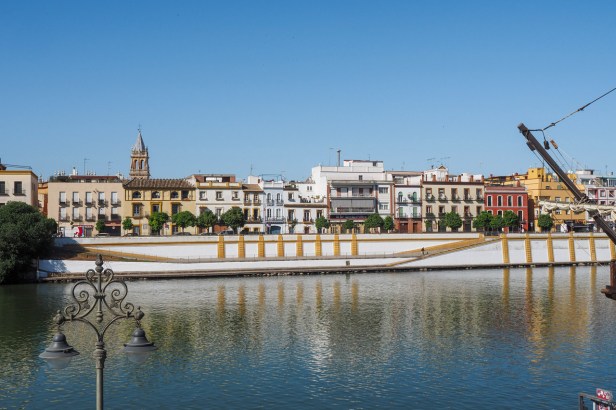
If you are planning to visit Sevilla – for the first time or returning – make sure to add the beautiful Triana neighbourhood to your itinerary. This small yet so authentic and lively barrio is definitely worth being explored.
Check out my little travel guide to Triana neighbourhood in Sevilla below for a quick introduction to the area and to know what to do and see before visiting Barrio de Triana for the first time.
What you should know about Sevilla’s Triana neighbourhood before visiting
Located on the west bank of Guadalquivir River, Barrio de Triana is only a short walk away from Sevilla’s main attractions on the other side of the river – yet feels very different.
The Triana neighbourhood was originally built as a Roman encampment, and it’s believed the area takes its name from Roman Emperor Trajan. Later, under Moorish rules it turned into a walled city which used to be an important strategic stronghold.
Thanks to its strategic location sitting between two branches of the Guadalquivir River, Triana has a strong seafaring history. Indeed, the many of the sailors taking part in historic voyages, including the discovery of America, were trained at Triana’s School of Seafarers.
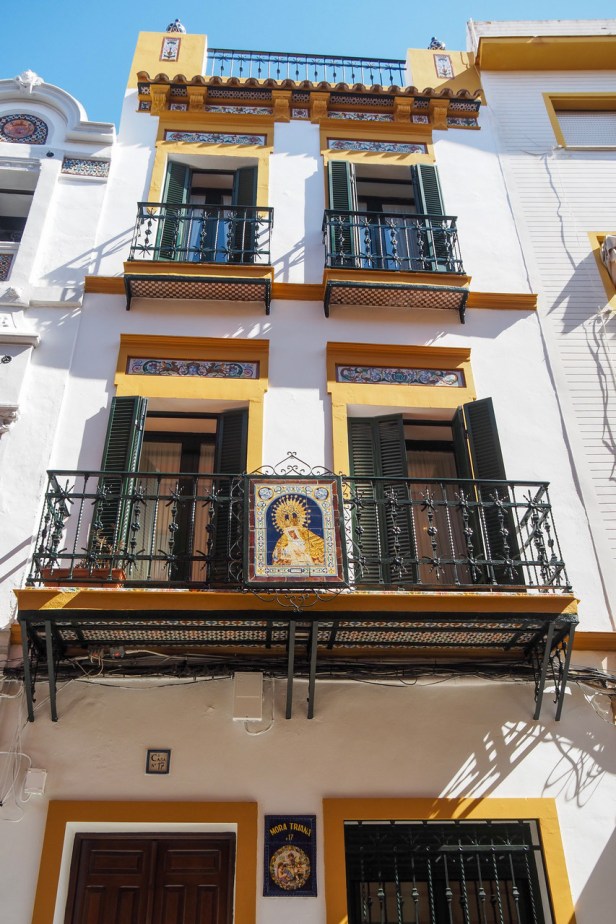
Meanwhile, Triana is perhaps best known for having been the home of many ceramics factories creating ceramic tiles (azulejos) and other pottery. Indeed, seeing all the beautiful tiles throughout all of Sevilla, you can well assume that they are form one of the ceramics factories in the past located in the Triana neighbourhood.
Triana is also dubbed to be the birthplace of flamenco, and with that it is not surprising the barrio is still considered one of the areas with the greatest flamenco traditions in Andalucía. It has indeed its own singing and dancing style, the Solerá di Triana.
Check out my list of thinks to do and see in the Triana neighbourhood of Sevilla.
What to do and see at Barrio de Triana, Sevilla

If you plan to visit Barrio de Triana, I recommend taking at least half a day to explore the area. And while it is above all the unique charm and authenticity of the quarter that makes it a great destination to explore, there are also a couple of historic sites you should certainly put on your itinerary.
Puente Isabel II (Puente de Triana)
These days, you only need to cross Puente Isabel II (also known as Puente de Triana) or alternatively Puente de San Telmo to reach the gorgeous, colourful Barrio de Triana.

This was quite different before Isabell II bridge opened in 1852. For centuries, Triana was not at all connected to the city of Sevilla on the other side of the river. It took until the end of the 12th century, for the first bridge to be set up by the Almohads, located right where Ponte Isabel II sits today. Nevertheless, crossing the river remained difficult considering the bridge was set up by boats tied one after the other, and thus fairly unstable and precarious to cross.

Ponte Isabel II is the oldest bridge in Sevilla and was build following the design of the later demolished Carrousel Bridge in Paris, which was originally built in 1834 by French engineer Polonceau.

Standing on the bridge or taking a walk along Calle Betis next to the river you will also be able to admire the beautiful panoramic backdrop of the Giralda Tower, Cathedral, and the bullring arena on the other side.
Capilla Virgin del Carmen
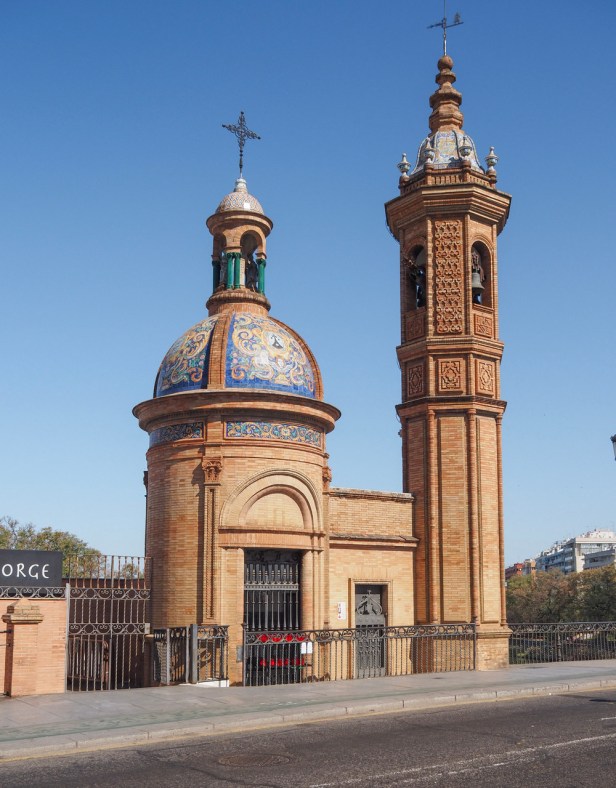
Arriving on the other side, just to the right end of Ponte Isabel II sits the impressive Capilla Virgin del Carmen, built in 1928. Owing to its small size, the church is locally known as ‘La Capillita’. A symbol of the Triana neighbourhood, it is home to the patron saint of the sea and the Spanish Navy, and the protector of fishermen.
Mercado de Triana
Right next to Capilla del Carmen, on the grounds of the former Castle of St. George (Castillo de San Jorge), sits one of the city’s most popular daily markets. Since 1823, the former site of the castle is home to the bustling Mercado de Triana. Make sure to visit in the morning or around lunchtime to make the most of the many food stalls selling fresh produce.
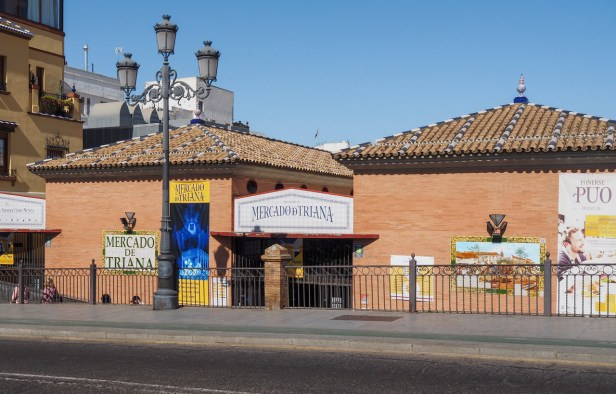
Meanwhile, Castillo de San Jorge, a medieval fortress was originally built during the 5th century by the Visigoths and enlarged during the 9th century under Moorish rule. When Sevilla came under Christian rule, the castle became the seat of the Spanish Inquisition and for more than 300 years remained the court and prison for religious ‘deviants’ as they were deemed at the time. In the 19th century, the fortress was demolished to make space for an extension of Plaza del Altozano square.
During a renovation of the Triana market in 1990, part of the castle’s old foundations was rediscovered and preserved under a glass coverage. This part of the site has now been turned into a museum also featuring multimedia exhibits about the Inquisition.
Capilla de los Marineros

The Chapel of the Sailors located in Calle Pureza is built in the typical style of the second half of the 18th century Sevilla. The church is home to the famous statue of the Virgin Esperanza de Triana. The statue plays an important role during the Semana Santa – the holy Easter week – when it will be carried various times from Capilla de los Marineros to the Cathedral of Sevilla.
Iglesia Santa Ana – Church of Santa Ana

Founded by King Alfonso X, the oldest parish church in Sevilla dates back to the 13th century. Initial constructions stated in 1276 by orders of King Alfonso X, with the church finished at the beginning of the 14th century. It was built by architects from Burgos in Gothic- Mudéjar style.

The church is home to several impressive sculptures, paintings, jewels, and religious items and legend has it that children baptised at Santa Ana Church will develop a particular talent for flamenco.
Triana Ceramics – Centro Cerámica de Triana
The Triana neighbourhood once used to be home to many ceramics factories. While most have gone, a couple of them continues to hold up the old tradition, which goes back to Roman times. A place not to be missed is Centro Cerámica de Triana. The centre sits in a former ceramic factory.

While there remain only few places to buy ceramics at Triana, the beautiful azulejos – the colourful ceramic tiles – are still present all over the barrio. Just look up to the balconies, adorned with this beautiful artwork.
Visit a flamenco show
You can’t visit Triana, the birthplace of flamenco, without attending a live performance right here.
Either head to Teatro Flamenco Triana, located in Calle Pureza, or head to one of the many small local flamenco bars offering a more intimate and authentic experience. Many of those smaller places, including El Rejoneo and Lo Nuestro on Calle Betis, La Taberna in Calle Duarte or Casa Anselma in Calle Pagés del Corro would not require to pay for the flamenco performance, while the hosts will make sure you order at least some drinks.
Enjoy the local Tapas scene
There is no shortage of tapas bars in Sevilla, and the Triana neighbourhood is no exception.

If you are planning a tapas crawl through Triana, or just want to have a little snack while exploring the neighbourhood, make sure to include Bar Santa Ana. It is located just across the Church of Santa Ana and while the tapas served here are not actually outstanding, sitting just opposite of the church enjoying a drink and a little bit of food still makes for a nice break.
Meanwhile La Antigua Abacería in Calle Pureza, Bodeguita El 24 in Calle Castilla, Cervecería La Grande in Calle San Jacinto are other places to enjoy some nice tapas and a glass of wine (or beer if you really need to).
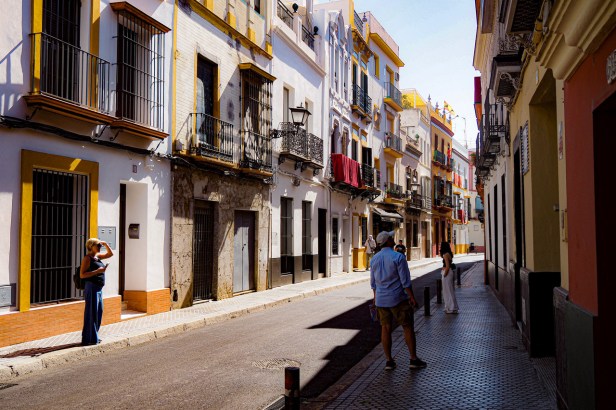
Did you ever cross into Triana neighourhood when visiting Sevilla? If the answer is no, this is a place that needs to be on your bucket list!
